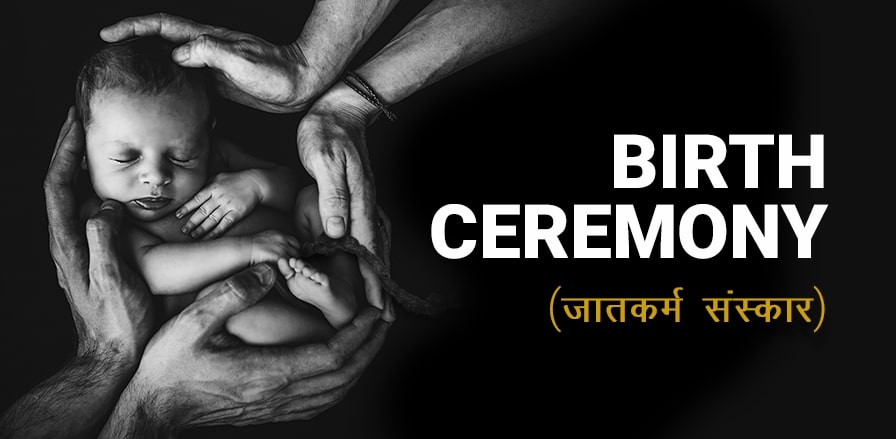Birth Ceremony (Jatakarma Samskara)
This is the first post-natal ritual performed immediately after the birth of the child and before the umbilical cord is severed. The essence of this ritual is to prepare the baby to be able to use the five senses independently. Read this article to learn about the auspicious time to conduct it, method to be followed, the science behind this ritual, etc.
The Birth Ceremony (Jatakarma Sanskar) is aimed at welcoming the baby into the world. Traditionally, this ritual was performed right after the birth of a child to check and activate its five sensory organs. This ritual is also an acknowledgement of the child as a separate individual, separate from the mother. Hence, the intention is to pray for the proper growth and development of the child outside the mother’s womb.
This forecast is based on Moon Sign. If you are not aware of your Moon Sign, find out instantly for free by filling the data below:
Vedic importance of this ritual
In Hindu tradition, this is the fourth important ‘samskara’ (ritual) performed right after the child is born and the first post-natal rite of passage for a new-born baby. Even before the child takes its first milk from its mother, this ritual is performed. When the umbilical cord is severed and the baby is cleaned and wrapped in a cloth, that is the right time to perform this ritual. However, in today’s scenario, when most of the births are taking place in the hospital, it is difficult to perform this ritual right at the hospital. So, it is being performed on the 5th or 6th day of birth after the baby is brought home. A little puja is conducted to commemorate this, which is also known as ‘paanchvi’ and ‘sahavi’ puja.
Purpose of this ritual
- To improve the intellect and health of the progeny.
- To pray for the child to achieve the optimum mental, physical, social and spiritual growth and development since the first 5 years of the child is a period of rapid growth.
- To minimize the teratological disorders.
- To ensure the right development of behavior pattern in the child since it is greatly influenced by environmental factors.
- To introduce stimulations to the baby that usually affect the intelligence level of the child.
Procedure to follow for this ritual
The father of the child utters a solemn vow (‘sankalp’): ‘I am performing the Jatakarma Samskara for the child for removal of all defects caused by drinking water in the womb and other defects of fetus and pray for the growth of its life and intellect.’
Post this the child is administered a mixture of honey and ghee in a very small quantity, given with the touch of a gold ring so that the essence of the gold is mixed in the mixture. The father should offer this honey mixture to the child by chanting a ‘mantra’ (sacred verse). This mantra which is recited while feeding the mixture of honey to the child is called ‘Madhu Sarpi Prashana Mantra’. After performing this ritual, the baby is handed over to the mother to nurse it.
Forgotten facts related to this ritual
In the fast-paced times that we live in, several aspects related to this ritual are forgotten. Some of them are listed below.
- Sprinkling of water over pregnant mother while chanting ‘mantra’ (sacred verses), seeking blessings for her.
- Cord cutting, cleaning of the child and handing over to the father.
- A yagna (puja by the sacred fire) is initiated for herbal fumigation.
- Baby is made to lick gold, ghee and honey while chanting sacred verses.
- The father smells the child’s head, which initiates a connection between the father and the newborn.
- Blessing the child with sacred verses.
- Cleaning the breast of the mother and feeding milk to the baby from the right side first by chanting sacred verses, and then the left side.
- A pot or kalash filled with water is placed near the head of the newborn baby to reduce or remove bacterial colonization.
- The father or the priest can be invited to do a small yagna (puja by a scared fire) by offering rice and mustard. It is recommended to do it twice during the day. The yagna also helps to purify the environment with its herbal fumigation.
The sacred verses to be recited by the father after a child emerges from the womb, the covering removed and the child cleaned:
‘Ma Nabhim Kritata Stanyan Ca Ma Datta’
This mantra should be chanted before cutting the cord and feeding breastmilk to the baby.
After that, the father is given the permission to cut the cord and chant this mantra:
‘Nabhim Kritata Stanyan Ca Datta’
The father then chants the below mantra while making the baby lick the ghee and honey mixture using a gold ring:
‘Om Prajapatih Vishnu Rishi
Anushoup Chandah
Shri Anato Devata
Brihiyavacurnena Jihva Marjjane Viniyogah
Om Iyam Ajna Idam Annam Idam
Ayuh Idam Ghritam’
The father should then take a bath. A kalash or pot filled with water is placed near the head of the newborn baby by chanting sacred verses.
Science behind this ritual
- Honey: It is a rich source of fructose, prevents respiratory infection and cleans the srotus (inner transport system of the body). It clears the secretion of the mouth and airways, prevents aspiration. Honey also provides instant energy and has antimicrobial, immunoenhancing and wound-healing properties.
- Ghee/butter: It maintains the temperature of the baby and provides insulation, prevents heat loss from the baby’s head, which has the largest surface area, thus preventing hypothermia. It lubricates oral mucosa and helps in internal wound-healing during mouth cleaning. It helps in early passage of stool due to the presence of LCT and inadequate digestion because of immature liver. It also prevents jaundice by reducing the bilirubin load in the enterohepatic circulation.
- Gold: It is an immunity booster, blesses one with intellect and longevity, improves memory, is healthy for the eyes, and has detoxifying properties. It acts as a cardiotonic and tones up the skin.
- Breastmilk: The mother’s milk, for the first few days, contains colostrum, a nutrient-rich ‘pre-milk’. It carries nutrients that boost a baby's immune system and helps it to fight infection.
- Licking of honey mixture: It gives an opportunity to the physician to assess the rooting and sucking reflexes of the neonate.
Through this ritual, the parents introduce the baby’s sensory organs to the new surroundings. A newborn baby perceives the sensory information from the environment, i.e., sound, smell, sight, touch of mother / father at birth and later sound and smell, etc. of other family members.
All these stimuli initiate the memory of the newborn.
The baby responds as per the parent’s emotions, body language and touch. For example: If the parents are lethargic and irritable, the baby may respond with irritability and crying.
Sacred verses recited during this ritual are also a way of stimulating responses to sound in the newborn. The auditory stimulus has the potency to provoke cognitive activities in children. The chanting of the sacred verses also stimulates the brain.
However, to be noted, sound intensity should not exceed more than 75 decibels, or else the newborn will be disturbed and might face hearing loss, physiological and behavioral disturbances as well.
The kalash or pot filled with water helps in removing insufficient heat and moisture in the lower respiratory tract that causes the ciliary cells to stop transporting. It should be kept for 10 days by the baby to help reduce or remove bacterial colonization.
Indastro top 10 Products
Translate











 Remedies to strengthen debilitated Rahu
Remedies to strengthen debilitated Rahu
 Business Fortune & Karma Reading
Business Fortune & Karma Reading
 Empowered Women in Career for all 12 Zodiac Signs
Empowered Women in Career for all 12 Zodiac Signs
 Astrological Tips for Good Luck in Different Days of the Week
Astrological Tips for Good Luck in Different Days of the Week
 Overseas Travelling & Settlement: Vedic Astrological Yogas
Overseas Travelling & Settlement: Vedic Astrological Yogas
